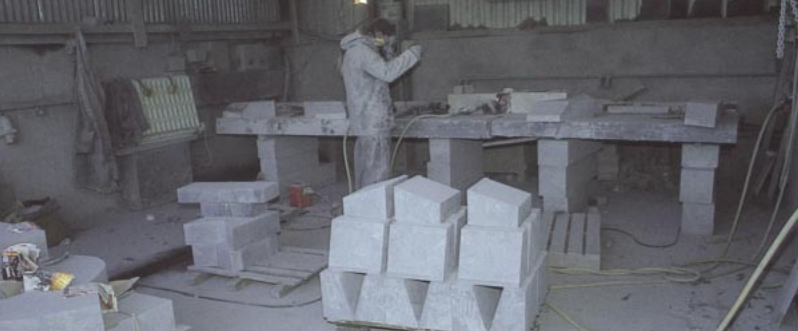
Irish Blue Limestone is tough and durable material but does require some care if it is going to maintain it’s original finish and appearance for the life of a building.
Surface Dirt
External limestone is most commonly specified with a matt surface finish that becomes slightly paler over time as a result of normal weathering.
Surface dirt on the exterior of a building should be removed by scrubbing with a bristle brush and clean water. Exposed ashlar and cladding may need to be cleaned in this manner at 10 to 15 year intervals to remove the build up of urban pollutants and maintain the appearance of the finish. Pressure washers, water spray or steam cleaning should only be undertaken in accordance with the guidelines in British Standard BS 6270 part 1: 1982 Code of Practice for Cleaning and Surface Repair of Buildings.
Oils, Paints & Detergents
All limestone surfaces are slightly porous and will absorb oils, greases and detergents and contact with these materials should be avoided. They often result in permanently discoloured patches which can be quite obvious on paler coloured finishes. The stone must be also protected from paints, varnishes and renders during routine maintenance as these will be leave indelible marks.
Graffiti
Alkaline chemical cleaners based on sodium hydroxide or potassium hydroxide can be used to remove graffiti. The original supplier of the stone can suggest specialist contractors for this task. These companies may also be able to apply specialist surface coatings that will limit the absorption of paints or oils. These coatings generally cause some discolouration and may result in a very patchy appearance over time.
Paths & Patios
When the Irish Blue Limestone is used for paving, algae may build up in lightly trafficked or shady areas. Ironically the improvement of air quality in the urban areas is making this a more common problem. Regular scrubbing with a stiff bristle brush and clean water will normally remove it. Algaecides should be used with care and must initially be tested on a small area to make sure they are not going to discolour or damage the surface. Routine use of pressure washers is not recommended as they will force water into the stylolites and degrade the surface.
Building Interiors
A clean dry stiff nylon brush should be used to remove dust from matt Irish Blue Limestone internal surfaces. Washing will tend to cause streaking and marking and is not recommended. Detergents, cleaning sprays or polishes used on the limestone itself or more commonly on adjacent finishes will result in staining. Even specialists have difficulties removing this type of marking or discolouration and maintenance staff should be made aware of this problem.
Where greasy marks may be transferred to the surface by contact with clothing or skin, it is preferable to specify a honed, flamed or polished finish rather than a matt finish.
Flooring
Washing with clean water and a soft mop is normally all that is required to restore the appearance of Irish Blue Limestone flooring. Clay and grit should be brushed or vacuumed off before washing, particularly when ground or sanded finishes have been specified. Specialist sealings are available to protect flooring tiles and the companies can supply details of suitable products.
Ground honed or polished limestone tiles must not be cleaned using industrial buffers as the abrasive pads will damage the surface.
Warning
Acid based cleaners and cement removers will cause irreparable damage to the structure and surface of Irish Blue Limestone and must not be used. Bathroom and kitchen cleaners designed to remove limescale from sinks and toilets will damage the finish on work tops, sink surrounds and tiles and should not be used.
